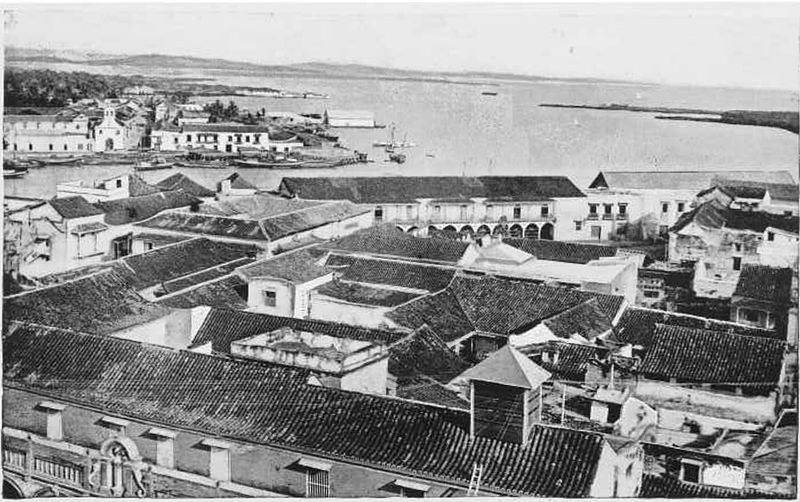37
No 7 Cartagena, Colombia
10th March 1891
My dear Mother,
My list tells me that I posted No 6 to you on the 1st inst by French Mail from Barranquilla.
I had to wait several days for a steamer to bring me here; finally a German boat came along, & though she was supposed to carry cargo only I could wait no longer. The food on board was neither varied nor plentiful but my fellow passenger, Clark, & myself, were not very exacting & we went for the ham, sausage, & blackbread, passed the sauerkraut, & consoled ourselves with deep draughts of excellent lager-beer, made deliciously cool by the ingenious plan of hanging the bottles in a damp canvas bag exposed to the breeze on deck, the evaporation having he same effect as if the bottles had been on ice for hours.
Cartagena is my Western limit & now I turn my face eastward, unlike “the youth who daily farther from the east must travel.”[1] On the 15th I hope to take the French steamer to Puerto Cabello, as there won’t be a direct boat for Curaçao for some time, but there is frequent communication between the two places mentioned.

Cartagena is a curious old town. It is really an island, having the sea on one side& the harbour on the other, while a narrow passage between these is spanned by a drawbridge.[2] All round the town are massive walls, built by the old Spaniards in the days of Indian slave labour. These walls measure from thirty to forty feet high & as much across; – I paced one part last night where the rampart was sixty feet across. The masonry is splendid – large blocks of stone bound as in a solid mass by mortar that they say cannot be made to-day. It is supposed that it was mixed with white of eggs, but that I venture to doubt. There are forts on the heights at the back of the town & at the entrance to the harbour, &, before the days of modern artillery, the place was practically impregnable. It has seen many a fight from the days of Drake & Captain Amyas Leigh down, & is still the spot where the victory is decided for one party or another during the periodical revolutions.[3]
To-day it is a hot place, a hungry place, & a dusty place, & generally – a most delightful place to leave behind. I have managed to scribble these few lines in haste, to take advantage of the quick mail by N.Orleans & N.York. I don’t know exactly when the next opportunity will be.
Best love
Jack.
Curaçao via N. York. Rivas Fensohn & Co[4] who will forward.
- Quote from William Wordsworth’s Ode: Intimations of Immortality from Recollections of Early Childhood: "The youth, who daily farther from the east Must travel, still is Nature’s priest" ↵
- During the colonial period, a drawbridge was raised at the foot of the channel of San Anastasio, which linked the walled city to the legendary Getsemani neighbourhood. https://en.wikipedia.org/wiki/Puerta_del_Reloj,_Cartagena. Once a district characterized by crime, Getsemani, just south of the ancient walled fortress, has become "Cartagena's hippest neighborhood and one of Latin America's newest hotspots" https://en.wikipedia.org/wiki/Cartagena,_Colombia#1811_to_the_21st_century ↵
- Captain Amyas Leigh Refers to the Character in Westward Ho!, the 1855 historical novel by Charles Kingsley, based on the experiences of Elizabethan privateer Amyas Preston (Amyas Leigh in the novel), who sets sail with Francis Drake, Walter Raleigh and other privateers to the New World, namely the Preston Somers Expedition and Raleigh's El Dorado Expedition where they battle with the Spanish. https://en.wikipedia.org/wiki/Westward_Ho!_(novel) ↵
- See Index to People ↵
